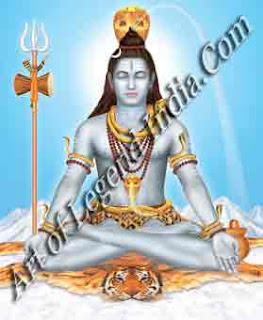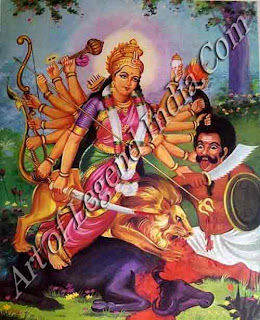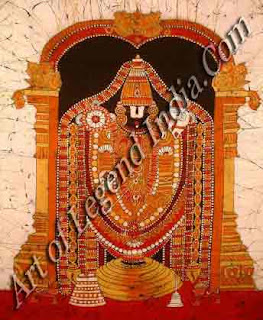 The
fifth sets of scriptures are the Agamas. These lay down the separate
theological disciplines and doctrines for the worship of particular deities.
Details of this type of worship will be covered later on. Suffice it to say now
that from these Agamas have sprouted the three main sects amongst the Hindus,
the Shaiva, Vaishnava, and Shakta.
The
fifth sets of scriptures are the Agamas. These lay down the separate
theological disciplines and doctrines for the worship of particular deities.
Details of this type of worship will be covered later on. Suffice it to say now
that from these Agamas have sprouted the three main sects amongst the Hindus,
the Shaiva, Vaishnava, and Shakta.
The
Shaiva Agama has led to the school of philosophy called Shaiva Siddhanta in the
south, and to the Pratyabhijna system of Shaivism of Kashmir. In this Agama,
the Supreme God is worshipped and adored under the different names and forms of
Shiva.
Similarly,
there are two main schools in the Vaishnava Agama, the Pancharatra and the
Vaikhanasa, both of which glorify Vishnu. Of these the former is more popular
and it is believed that this Agama was revealed by the Great God Himself in the
form of Vishnu.
The
Shakta Agama glorifies Devi, the consort of Shiva, as the World Mother who, as
Shakti, is the energy-giving power behind all Creation, Creativity and
Destruction.
The
Tantric cult owes its origin to the Tantras and not to the Vedas (and therefore
is not Hindu), but in the later period of Hindu history, Tantrics started to
claim allegiance to the Shakta Agama. Many occult and magical practices trace
their origin to Tantric worship as does much of the erotic art that we see on
the walls of some temples to this day. However the Tantric cult was never fully
accepted by Hinduism nor by the more important Hindu philosophers.
This
set of scriptures, the Agamas, guides the faithful who are moved by their
devotion to the Supreme God to worship one of His manifestations.
 Each
Agama, in turn, has several sections. The first part consists of the philosophy
and spiritual knowledge behind the worship of the deity. The second part covers
the Yoga and the mental discipline required for each school of worship.
Each
Agama, in turn, has several sections. The first part consists of the philosophy
and spiritual knowledge behind the worship of the deity. The second part covers
the Yoga and the mental discipline required for each school of worship.
An
important part of the third section in each Agama covers the rules for
constructing temples. That is why, whatever the style of outward architecture,
the plan of temples is the same in whatever part of the country a temple is
situated. Some are more elaborate than others with the addition of mandapas or
halls, but the basic plan is the same, as laid down in each Agama for
accommodating the rituals in that form of worship. Worship, even in temples, is
individual, not congregational, which explains the small-sized sanctum
sanctorum and narrow paths for circumambulation (walking around the shrine,
chanting prayer hymns). Equally important in the third section are the rules
for sculpting or carving figures of deities and divinities. Even details such
as the way Rama holds his bow, the length of his arms, the graceful stance of
Seeta are written down so that, in whichever part of this vast country a temple
is built, these rules are followed. The only differences are in the facial
features of the images which are usually patterned on the racial
characteristics of the local population.
 The
fourth part of the Agamas consists of the rules pertaining to the observances
of religious rites and rituals at home and in the community, and in the
observance of religious festivals. These are given in great detail, which
explains their being observed from one end of the country to the other, with
only local cultural variations.
The
fourth part of the Agamas consists of the rules pertaining to the observances
of religious rites and rituals at home and in the community, and in the
observance of religious festivals. These are given in great detail, which
explains their being observed from one end of the country to the other, with
only local cultural variations.
The
most beautiful aspect of the Agamas is the tremendous amount of poetic
compositions and devotional songs that have sprung up under the shade of these
theological scriptures in all the languages of the country. They have added
greatly to the richness of the poetry and literary genius of our great land.
Writer
– Shakunthala Jagannathan
 The
fifth sets of scriptures are the Agamas. These lay down the separate
theological disciplines and doctrines for the worship of particular deities.
Details of this type of worship will be covered later on. Suffice it to say now
that from these Agamas have sprouted the three main sects amongst the Hindus,
the Shaiva, Vaishnava, and Shakta.
The
fifth sets of scriptures are the Agamas. These lay down the separate
theological disciplines and doctrines for the worship of particular deities.
Details of this type of worship will be covered later on. Suffice it to say now
that from these Agamas have sprouted the three main sects amongst the Hindus,
the Shaiva, Vaishnava, and Shakta.  Each
Agama, in turn, has several sections. The first part consists of the philosophy
and spiritual knowledge behind the worship of the deity. The second part covers
the Yoga and the mental discipline required for each school of worship.
Each
Agama, in turn, has several sections. The first part consists of the philosophy
and spiritual knowledge behind the worship of the deity. The second part covers
the Yoga and the mental discipline required for each school of worship.  The
fourth part of the Agamas consists of the rules pertaining to the observances
of religious rites and rituals at home and in the community, and in the
observance of religious festivals. These are given in great detail, which
explains their being observed from one end of the country to the other, with
only local cultural variations.
The
fourth part of the Agamas consists of the rules pertaining to the observances
of religious rites and rituals at home and in the community, and in the
observance of religious festivals. These are given in great detail, which
explains their being observed from one end of the country to the other, with
only local cultural variations.










0 Response to "The Agamas of God"
Post a Comment